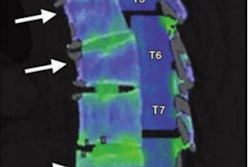Wednesday, December 4 | 3:00 p.m.-3:10 p.m. | SSM05-01 | Room N226
Together, the combination of dual-energy CT (DECT) and conventional CT can differentiate primary lung cancer from lung metastases more effectively than either of the techniques alone, according to this study to be presented on Wednesday.In recent years, several studies have demonstrated the potential of DECT-derived parameters to improve diagnostic workup of pulmonary lesions, noted presenter Dr. Dominik Deniffel of Lunenfeld-Tanenbaum Research Institute in Toronto.
"Our exploratory study focuses on a common diagnostic challenge that has not yet been addressed: Upon appearance of a suspicious lung lesion, can we differentiate metastatic disease from primary lung tumors using quantitative imaging parameters?" he told AuntMinnie.com.
The group, led by Dr. Daniela Pfeiffer of Technical University of Munich in Germany, sought to address this question by examining the contrast-enhanced DECT and conventional CT scans of roughly 200 patients with either primary lung cancer or lung metastases from breast, colorectal, head and neck, kidney, and pancreatic cancer.
The researchers found that combining both DECT and CT data to distinguish primary lung cancer from metastases led to statistically significant improvements in diagnostic accuracy, compared with using either DECT or CT alone (p < 0.01). The combined method also achieved higher sensitivity and specificity.
"Evaluation of pulmonary lesions of unknown origin should, therefore, include both conventional and dual-energy CT derived parameters, since they provide complementary information to one another," Deniffel said.




















